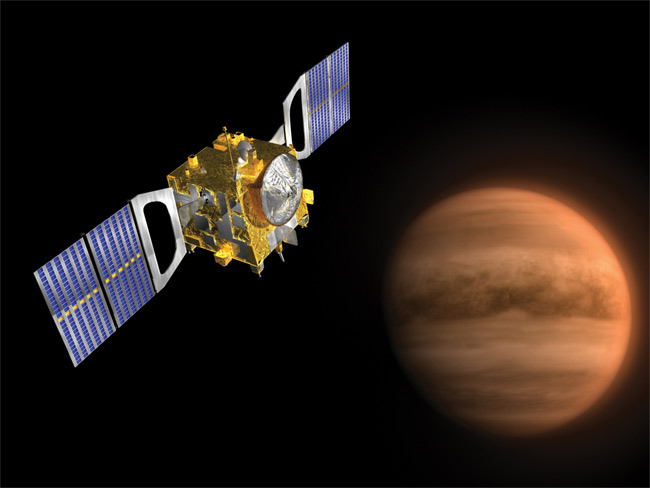Spacecraft Skims Venus Atmosphere for Science

A European-built spacecraft has used its solar wings assails to skim through the sweltering atmosphere of Venus at the planet'soutermost border with space.
The European Space Agency's (ESA) Venus Express spacecraftconducted five "aerodrag" maneuvers last week, which used the orbiteras a sensor capable of very accurately measuring the atmospheric density just 111miles (180 km) above the cloud-enshroudedplanet.
To do these aerodrag measurements, the solar panels of VenusExpress were rotated through five sets of orientations, which changed daily, toexposed the wings to the vanishingly faint wisps of Venus'atmosphere at its boundary with space.
The solar wing configuration generated a tiny but measurableamount of aerodynamic torque, or rotation, on the probe. This torque can bemeasured very accurately based on the amount of correction that must be appliedby reaction wheels, which counter-rotate inside the spacecraft to maintain itsorientation in space.
That correction data, in turn, tells scientists just howthick or thin the atmosphereof Venus is at the point the spacecraft was during the maneuver.
On the last day of the aerodrag campaign, which ended onApril 16, the solar arrays were rotated at plus and minus 45 degrees to theatmospheric flow, mimicking the vanes of a windmill. They maneuver allowedVenus Express to gather more information on the behavior of the molecules of Venus'atmosphere as they bounced off the probe's solar wings.
"The aerodrag campaign went without problem, andconclusively demonstrated that VenusExpress can be securely and accurately used to sense the density of theplanet's atmosphere," said Octavio Camino, the probe's spacecraftoperations manager. "Venus Express has shown once again that it is a verycapable satellite."
Get the Space.com Newsletter
Breaking space news, the latest updates on rocket launches, skywatching events and more!
Camino said that the mission operations team will study lastweek's results to develop an optimised configuration for aerodrag campaigns inOctober and in 2011. Aerodrag testing was also conducted in 2008, 2009 andFebruary 2010.
Continued positive results may enable Venus Express toconduct more sophisticated investigations deeper in the atmosphere, which wouldbe of immense interest to planetary scientists.
The spacecraft launched toward the cloud-covered secondplanet of the solar system in 2005 and arrived at Venusa year later. The mission was extended for four months in May 2009, and thenreceived another reprieve in September 2009 ? this time, extending the missionto 2010.
Aerobraking demonstrations are expected to follow through atleast 2011 or 2012, ESA officials have said.
- Top10 Extreme Planet Facts
- SeeBeneath the Clouds of Venus
- Images- Postcards from Venus
Join our Space Forums to keep talking space on the latest missions, night sky and more! And if you have a news tip, correction or comment, let us know at: community@space.com.

Space.com is the premier source of space exploration, innovation and astronomy news, chronicling (and celebrating) humanity's ongoing expansion across the final frontier. Originally founded in 1999, Space.com is, and always has been, the passion of writers and editors who are space fans and also trained journalists. Our current news team consists of Editor-in-Chief Tariq Malik; Editor Hanneke Weitering, Senior Space Writer Mike Wall; Senior Writer Meghan Bartels; Senior Writer Chelsea Gohd, Senior Writer Tereza Pultarova and Staff Writer Alexander Cox, focusing on e-commerce. Senior Producer Steve Spaleta oversees our space videos, with Diana Whitcroft as our Social Media Editor.









